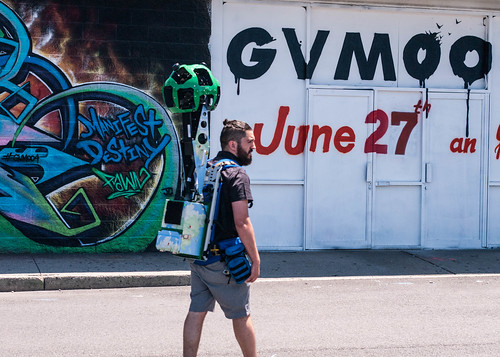While the human act of marking walls goes back 10s of thousands of years, aerosol graffiti is quite recent and, in its current form, is often propagated around the world through digital images residing on the web. With that in mind, consider the following photo, taken at the site of Green Villain’s Demolition Exhibition in the Newport area of Jersey City:
The man is Omar, and he works for Google Street View. The contraption on his back is a Trekker camera, which Google developed for photographing streets. While the camera was originally development for deployment on top of an automobile which drives the streets and photographs the scene, this version allows access to off-street areas. In this case Omar is walking around a building that is covered with graffiti. Omar’s compatriot, whose name I forget, went inside the building with a slightly different version of the camera, one mounted on a frame you can push along the floor.
The building used to be a Pep Boys store. Pep Boys, as you know, services automobiles and sells parts, accessories, and supplies. Pep Boys is thus about the automobile, a technology which dominated American life in the second half of the 20th century, though it originated in the 19th century.
Street View is also about the automobile, but it’s 21st century technology based on computers. Google itself arose in the last decade of the 20th century as a search engine for the web; and that is still the center of its business. At some point, though I forget just when, it also started serving up street maps, and it created Street View to augment that business.
Street View images live online. They don’t come bundled up with paper maps you buy at a gas station or from AAA. The camera is itself 19th century technology, with antecedents going back a century or three before that, but the Trekker system combines lasers and GPS and digital computing, all late 20th century tech.
Graffiti of the sort on and inside this building originated in the late 1960s and early 1970s. It is based mostly, though not entirely, on paint delivered by aerosol cans. The aerosol can originated in the mid-20th century. During the 1970s and 1980s the subway system of New York City was the most important site of graffiti development. Subways are, of course, train technology, which dates back to the early 19th century, with electrification coming at the end of the century.
So, graffiti originated with the application of paint using 20th century technology to trains based in 19th century technology. When the web bootstrapped onto the Internet in the mid-1990s graffiti followed almost immediately. It will be six months or more before the images Omar took will go live on the web. But when that happens, we will be taking another step into a new era in graffiti culture.

No comments:
Post a Comment